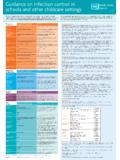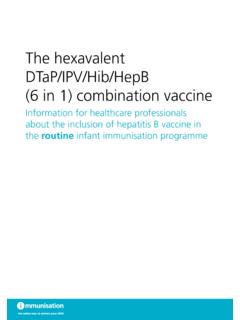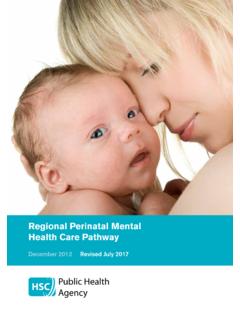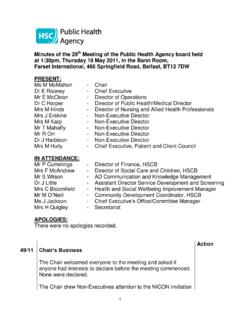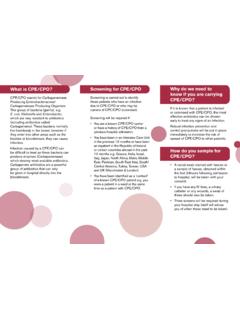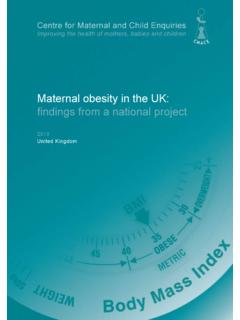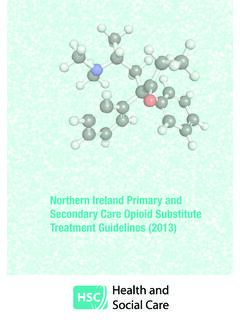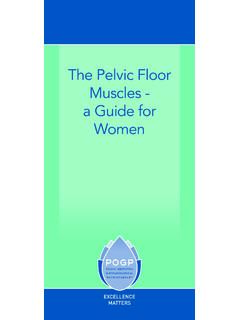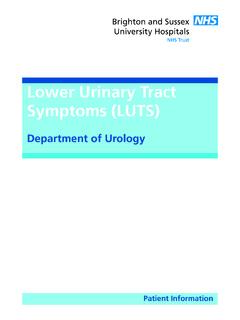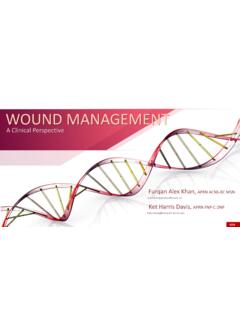Transcription of Pressure area care - Health and Social Care
1 YourturnCampaigning to prevent Pressure area careLearner information packand workbookNameIntroductionPressure ulcers/sores are a common problem, which can severely affect the quality of life for individuals. However with good care , most can be avoided, by removing the causes of Pressure this unit, you need to be able to undertake Pressure area care for individuals, following the individual s care plan and risk assessment, as well as relevant protocols and procedures within your work area . The aim is to maintain healthy skin and thus prevent breakdown and the development of Pressure will learn about the risk factors that make an individual more susceptible to developing Pressure ulcers, changes in skin condition to look out for and how to position individuals to reduce Pressure . The unit also covers the equipment and materials for maintaining hygiene, moving, handling and positioning individuals as well as Pressure relieving aids.
2 It stresses the importance of taking adequate Health and safety precautions, providing physical and emotional support and working as a team with other professionals, the individual and their the unit, you will have the opportunity to demonstrate your learning through activitiesand The normal structure and function of the skinThe skin is an amazing organ. Measuring around two square meters and accounting for up to 15% of your body weight, it is the largest and heaviest organ of your body. It is made up of three layers: The epidermis this is the thin outer layer of the skin that you can see when you look at yourself. It is only about thick and does not have its own network of blood vessels, so that it has to get its nutrients from the underlying dermal layer. Every four weeks the epidermis completely renews itself as the outer cells are worn away and replaced with new ones from underneath. The dermis this lies beneath the epidermis, it is about thick and is the active part of the skin.
3 It contains blood vessels, nerves, hair follicles, sebaceous (oil) and sweat glands and lymphatics. The dermis contains collagen, fat and elastin fibres which give the skin its strength and flexibility. The hypodermis this is a layer of subcutaneous fat under the dermis. It also contains blood vessels and connective tissue. It forms a protective layer over the underlying organs and structures and also acts as an energy source for the body and provides insulation from changes in the outside of sweatgland ductEpidermisDermisSweat glandSubcutaneouslayer (Hypodermis)Hair shaftStratum corneumNerve fibresStratum germinativumNerve fibresBlood vesselsBasement membranePaccinian corpuscieThe skin has several different functions, but its main job is to protect the body. It does this by: Regulating temperature when the outside temperature rises, the body is cooled by the production and evaporation of sweat from the skin. Blood vessels in the skin dilate to increase blood flow near the surface of the skin (that s why you go red when you get hot) so that heat can be radiated away from the body.
4 When the outside temperature falls, the skin tries to insulate the body by forming goose bumps, this makes the hairs stand up trapping warm air near the body and the blood vessels contract to limit the heat lost at its surface. Forming a physical barrier the skin helps to shield the body from mechanical, thermal or chemical damage. It also protects you from UV radiation, bacterial invasion and stops you becoming dehydrated. Providing sensation nerve endings within the skin can detect changes in temperature and Pressure . They can also detect vibration and pain. Excreting waste products the skin is one way in which the body gets rid of excess heat, water, salts and toxic organic compoundsThe skin is considered to be an organ because one of its important functions is to help in the production of Vitamin D. When your skin is exposed to sunlight, the UV rays activate modified cholesterol in the dermis to produce Vitamin D.
5 This is needed to help the body absorb calcium to form healthy appearance of the skin is important because if damaged or abnormal in any way, it can affect an individual s body image and quality of life. For example a teenager who develops severe acne may become very self-conscious, lose their confidence and stop skin plays a part in communicating with others. Like body language, changes in skin colour (eg blushing), facial expression and body odour can all give clues as to how an individual is really feeling. Sometimes this may be at odds with what the individual is actually 11. What are the three layers of the skin? Briefly describe each Name four protective functions of the skin3. Why is the skin considered to be an organ? How Pressure ulcers developPressure ulcers, often called bed sores, can be a problem for individuals in a hospital or care setting. They develop when Pressure , shear or friction to the skin and the underlying soft tissues closes or damages local capillary, venous or lymphatic networks.
6 The cells around the closed vessels die and if the Pressure is not removed, the damage will severity of the damage can range from reddening of the skin, to large cavity wounds with damage to muscles and even may be caused by: low Pressure for prolonged periods (eg lying in bed for hours without moving) high Pressure for relatively short periods of time (eg rough handling when being moved or lying on the floor following a fall) Pressure from equipment being used to monitor or treat an individual (eg urinary catheter, oxygen tubing).The most common sites for Pressure ulcers to develop are: the sacrum (the curved triangular bone just above the buttocks) - accounts for over 30% of all Pressure ulcers; the heels accounts for 25-30%; the ischial tuberosities (buttocks) accounts for around 10%.Activity 2 Draw on the figure to show where you think the Pressure areas would be on a person lying in bed on their The importance of using Pressure ulcer damage risk assessment toolsIndividuals who are confined to a bed or wheelchair, or who spend a long time sitting each day are particularly prone to developing Pressure ulcers.
7 However some individuals are more at risk of developing Pressure ulcers than others, and a number of factors have been identified as being important in predicting who is most at risk. There are now several risk assessment tools available to help you identify who will need most preventative care . A good risk assessment tool should look at both the intrinsic and extrinsic risk clothesOcciputScapulaVertebraeElbowSacru mHeelToesEarUpper humerusElbowTrochanter of femurThighLower legHeelLateral and medial malleolusElbowRib cageBed surfaceThighPatellaToesCommon Pressure areasIntrinsic risk factors these are factors to do with the individual and include: Age those over 65, neonates and very young children are at highest risk. Health if the individual is unwell, they are at increased risk. Acute illness can cause changes in the body s normal functioning eg raised temperature, low blood Pressure , constriction of the blood vessels.
8 Chronic or terminal illness may result in reduced mobility or poor circulation. Certain medications can also increase the risk, eg by increasing sedation. Level of consciousness if the individual becomes unconscious, he or she will not be able to change position to reduce Pressure eg following surgery. Weight obese individuals are more at risk, because there is more weight on the Pressure points underweight individuals are also more at risk. Nutritional status those who are malnourished or dehydrated are at most risk. Poor nutrition can affect the elasticity of the skin and its ability to fight infection. Previous history individuals who have suffered from Pressure damage in the past are more likely to develop Pressure sores. Mobility patients who have reduced mobility or are immobile are most at risk, because they are less able to relieve Pressure by moving position. Sensory functioning individuals with sensory impairment (eg those unable to sense pain due to nerve damage or spinal injury) may not receive the stimulus to move to relieve Pressure and are at greater risk.
9 urinary or bowel incontinence Vascular disease individuals with poor circulation due to damaged or partially blocked blood vessels are at increased risk of Pressure damage. This is due to reduced blood volume and reduced flow of blood in the arteries and capillaries supplying the skin and underlying risk factors - these are factors to do with the surrounding environment eg Amount of Pressure eg from tubing ( urinary catheter, oxygen tubing) Type of Pressure eg from being moved across a bed Duration of Pressure eg how long the individual remains in the same position Level of care available eg patient s care package and family support Type of mattress using low Pressure foam mattresses may reduce the risk Design of seat or wheelchair Education showing individuals how to sit correctly and explaining why frequent repositioning is important can reduce the risk External influences upon the skin such as urine, faeces, starch from sheets, perfumes etcRisk assessment tools, combined with clinical judgment of the nursing staff are used to formulate the individual s care plan to prevent Pressure ulcers developing and to treat or manage any already Registered Nurse will carry out a risk assessment when a patient is admitted under their care .
10 89 Activity 3Mr Brown is 67, weighs more than he should (15 stone when his height is only 5ft 7ins), he has a history of high blood Pressure and is recovering from a hip replacement What are the factors that put Mr Brown at risk of developing Pressure ulcers?Mrs Smith is 75; she is in the terminal stages of breast cancer and is confined to bed. She finds it difficult to eat, and needs diamorphine to help control the pain. Unfortunately this medication makes her very drowsy and she spends much of the day drifting in and out of What are the factors that put Mrs Smith at risk of developing Pressure ulcers? The prevention and management of Pressure ulcersThe best way of preventing Pressure damage from starting or getting worse is to remove the cause. This can be done by: Getting individuals mobile again so that they can change position by themselves Making sure that individuals are regularly repositioned to relieve Pressure over bony prominences Keeping time spent on the damaged area to a minimum Using a suitable support surface such as a foam mattress or a well-designed and adjustable chair or one of the many types of Pressure reducing aids available Keeping the skin clean and dry using simple non-perfumed products for washing the skin Taking precautions to prevent infection Moving and handling individuals with great care to prevent friction, abrasion or stretching of the skin Educating patients on how to avoid damage113.
